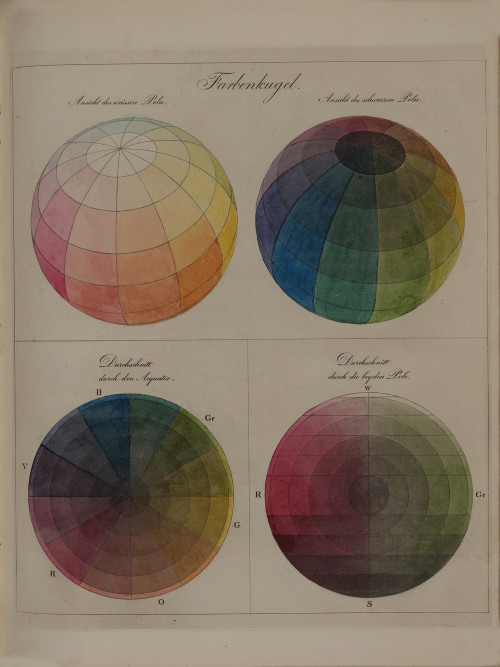Philipp Otto Runge applied himself to the theme of colour not just in practice, but also in theory. He was well acquainted with older and more recent research on colour. Starting in 1806, he corresponded regularly with Goethe, whose experiments had sparked his interest in the spectral colours created by the refraction of light.
Himself an artist, Runge wanted his practical deliberations to be of help to painters. So he devoted special effort to the study of pigments — that is, artists’ actual working materials. He was particularly interested in the relationships between the colours, their harmonies and disharmonies. To structure his findings comprehensively, he invented a three-dimensional colour model. In the spring of 1810, after years of work, he finally published his Colour Sphere, or Construction of the Relationships Between All Colour Mixtures.
For his Colour Sphere, Runge used terminology related to the terrestrial globe, for example “equator” and the “poles”. He placed the three colours blue, yellow, and red at equal distance to one another on the equator, between them the mixed colours green, orange, and purple. He assigned white and black to the poles. Now every colour could mix with every other in all directions, in brighter shades towards the top and darker towards the bottom. And finally, he also provided for a progression in the sphere’s interior, where the gradations end at the very centre in pure grey. In this display, a three-dimensional model supplements Runge’s explanatory colour charts.
Even if Runge created his colour system with mathematical precision, his theory also accommodates emotional aspects. Colours bear “affinities” or “enmities” to one another. White and black are comparable to “light” and “darkness”. Much in keeping with Goethe’s holistic approach, Runge considered the effect of colour and its comprehension neither a purely scientific nor a purely technical matter. Goethe’s Colour Circle watercolour painting is also on view in this installation. Here Goethe assigned the different colours human qualities and the gradations certain aspects of the intellect and the soul.
Goethe sent Runge his two-volume Theory of Colours in the spring of 1810. The didactic section includes a reprint of a letter from the artist. Runge was never able to make practical use of his findings on colour in paintings: in December 1810, at the age of just thirty-three, his life came to an untimely end. With his Colour Sphere, however, he had illustrated his idea that it is the colours that sustain the world and form the cosmos.
Objekte
-

PHILIPP OTTO RUNGE
Farben-Kugel oder Construction des Verhältnisses aller Mischungen der Farben zu einander, und ihrer vollständigen Affinität, mit angehängtem Versuch einer Ableitung der Harmonie in den Zusammenstellungen der Farben. Von Philipp Otto Runge, Mahler. Nebst e
Hamburg: Perthes 1810.
-
JOHANN WOLFGANG VON GOETHE
Wheel in watercolours, 1809